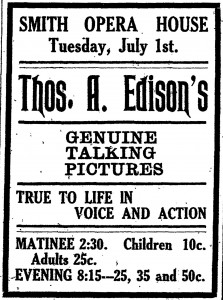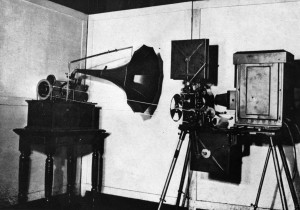SMITH HISTORY BLOG: Talking Pictures at the Smith
by Austin Jennings

An advertisement for the exhibition of Thomas Edison’s kinetophone at the Smith Opera House, found in a Geneva Advertiser-Gazette from 1913.
Considering that commercial movie theatres were not in existence 125 years ago, it’s interesting to note that the Smith has lived through nearly the entire history of the American movie industry. It has therefore lived through the countless technological developments of movies, including the synchronization of recorded sound to motion pictures. These days it’s something we often take for granted, but back in 1913 the Smith Opera House witnessed the forefront of that development with an exhibition of Thomas Edison’s kinetophone (“Edison’s Talking Pictures”)! It was so early in the development of movies that, after that event, talking pictures did not return to the Smith until 18 years later (McNally 56).
Similar to when the Edison Tone Test was performed at the Smith, Edison himself was seemingly not in attendance when his working kinetophone was shown in Geneva. Despite that, the Smith’s participation in the earliest of sound pictures is still an extremely special moment in film history. While many people regard the 1927 film The Jazz Singer as the first commercial talking picture, the films shown by Edison’s kinetophone were the true pioneers of sound synchronization with motion pictures. An important technological difference between the two was that the Jazz Singer’s sound was electrically recorded, whereas the kinetophone used a less advanced and more mechanical method (“Sound; Talking Pictures Mark an Obscure Anniversary”). Edison’s kinetophone was essentially just his phonograph and projector, where “a celluloid cylinder record measuring 5 1/2″ in diameter was used for the phonograph [and] synchronization was achieved by connecting the projector at one end of the theater and the phonograph at the other end with a long pulley” (“Early Edison Experiments with Sight and Sound”). Unfortunately the popularity of the kinetophone was short-lived, with Edison abandoning the project by 1915. Many factors contributed to its demise, but one was that it took a skilled projectionist to maintain the synchronization of the picture and sound. Once the films were shown widespread and untrained projectionists had to be used, audiences were extremely unhappy with the unsynchronized product (“Early Edison Experiments with Sight and Sound”).
After the kinetophone showing, the Smith continued to show silent films as it had done for many years prior. Again, commercial talking pictures did not exist once more in America until The Jazz Singer and they didn’t return to the Smith for a few more years in 1931. That return came in the form of Parlor, Bedroom, and Bath, starring Buster Keaton, at the grand reopening of the Smith under the name Schine’s Geneva Theater. The newly refurbished theatre was purpose built for talking pictures (“Geneva’s New Theatre”). Thus, the silent film era of the Smith had ended and movies with sound became the norm.
Works Cited
“Early Edison Experiments with Sight and Sound.” Library of Congress, “Inventing Entertainment: The Early Motion Pictures and Sound Recordings of the Edison Companies” collection, https://www.loc.gov/collections/edison-company-motion-pictures-and-sound-recordings/articles-and-essays/early-edison-experiments-with-sight-and-sound/.
“Edison’s Kinetophone.” Hulton Archive, Getty Images. PBS Learning Media, https://cptv.pbslearningmedia.org/resource/3285606-industrial-revolution/edisons-kinetophone-industrial-revolution/.
“Edison’s Talking Pictures.” Geneva Advertiser-Gazette, 26 June 1913. Rochester Regional Library Council. NYS Historic Newspapers.
Fantel, Hans. “Sound; Talking Pictures Mark an Obscure Anniversary.” The New York Times, 9 January 1983, https://www.nytimes.com/1983/01/09/movies/sound-talking-pictures-mark-an-obscure-anniversary.html.
“Geneva’s New Theatre.” Penn Yan Democrat, 13 March 1931. Rochester Regional Library Council. NYS Historic Newspapers.
McNally, Charles. The Revels in Hand: The First Century of the Smith Opera House October 1894 – October 1994. Finger Lakes Regional Arts Council, 1995.
